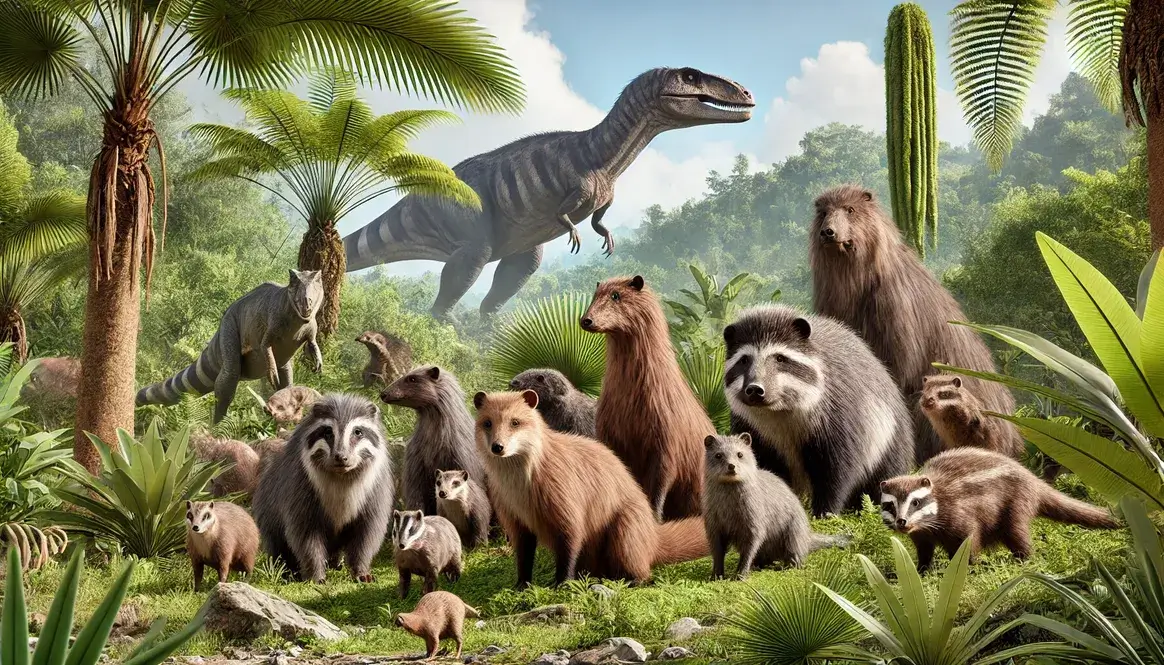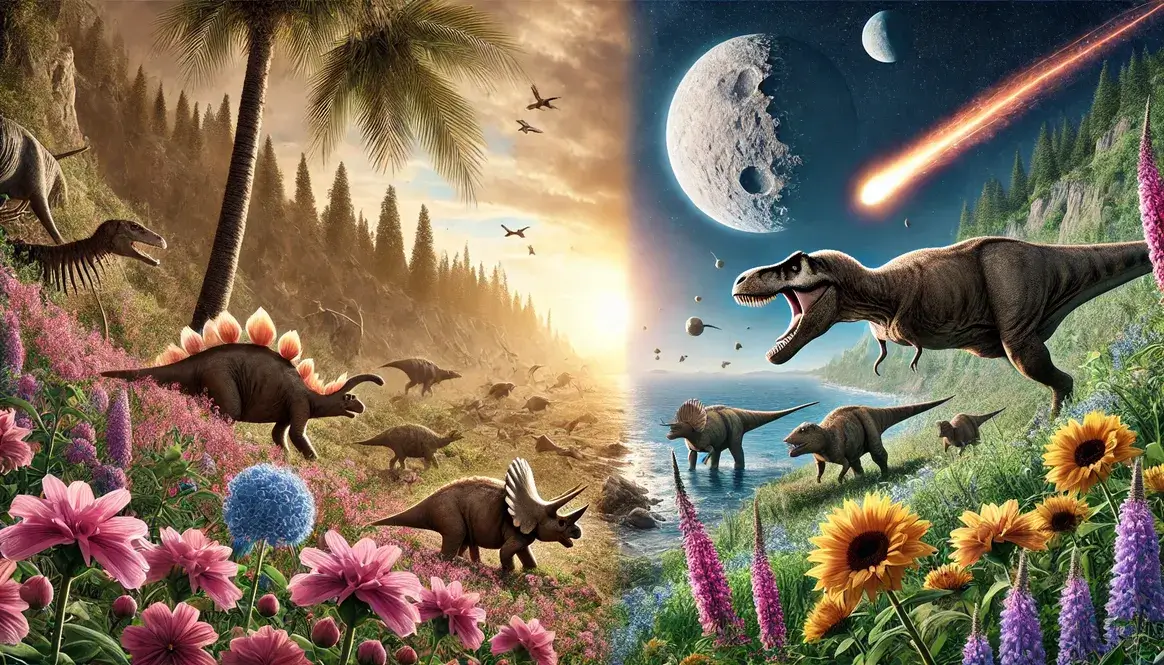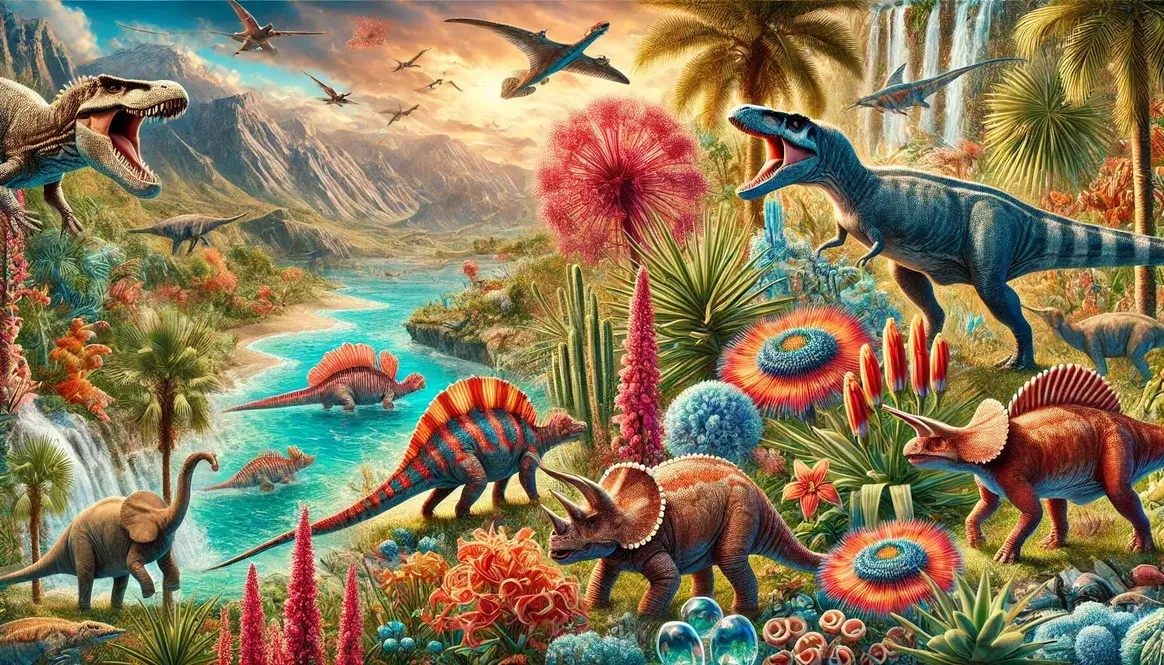The Cretaceous period, spanning from 145 to 66 million years ago, is often associated with the reign of dinosaurs. However, this era also saw the rise and diversification of an equally important group: mammals. These small, furry creatures played a crucial role in shaping the evolution of life on Earth, despite living in the shadow of their giant reptilian neighbors.
Cretaceous mammals were remarkably diverse, occupying various ecological niches and developing key adaptations that would later prove essential for their survival and dominance after the extinction of the dinosaurs. Let’s explore the fascinating world of these tiny pioneers and their journey through one of the most dynamic periods in Earth’s history.
Diversity of Mammal Groups in the Cretaceous
The Cretaceous period witnessed an explosion of mammalian diversity, with several distinct groups emerging and evolving alongside the dinosaurs. These groups laid the foundation for the mammalian lineages we see today.
Multituberculates: The Successful Rodent-like Mammals
Multituberculates were among the most successful and long-lived mammal groups of the Mesozoic era. These small, rodent-like creatures first appeared in the Jurassic period and thrived throughout the Cretaceous.
Key characteristics of multituberculates:
- Distinctive teeth with multiple cusps, ideal for grinding plant material
- Long, flexible bodies suited for climbing and foraging
- Diverse diets, ranging from seeds and fruits to insects
Multituberculates were remarkably resilient, surviving the mass extinction event at the end of the Cretaceous and persisting well into the Cenozoic era. Their success can be attributed to their adaptability and efficient feeding strategies.
Metatherians: Early Relatives of Marsupials
Metatherians, the ancient relatives of modern marsupials, also emerged during the Cretaceous period. These mammals were characterized by their unique reproductive strategy, which involved giving birth to underdeveloped young that completed their growth in a pouch.
Some notable features of Cretaceous metatherians:
- Small body size, typically no larger than a house cat
- Diverse tooth structures, indicating a variety of diets
- Presence of epipubic bones, which supported the pouch in females
While metatherians were widespread during the Cretaceous, they faced significant challenges after the mass extinction event. Today, marsupials are primarily found in Australia and the Americas, reflecting their evolutionary journey since the Cretaceous.
Eutherians: Ancestors of Placental Mammals
The Cretaceous period also saw the rise of eutherians, the group that would eventually give rise to placental mammals – including humans. These early eutherians were small and insectivorous, but they possessed key adaptations that would prove advantageous in the post-dinosaur world.
Characteristics of early eutherians:
- Development of a placenta for nourishing offspring in the womb
- Diverse tooth structures, allowing for a variety of diets
- Improved hearing and sense of smell compared to earlier mammals
Eutherians would go on to become the most diverse and widespread group of mammals, encompassing everything from tiny shrews to massive whales.
| Mammal Group | Key Features | Ecological Role | Modern Descendants |
|---|---|---|---|
| Multituberculates | Multiple cusped teeth, flexible bodies | Herbivores, omnivores | Extinct |
| Metatherians | Pouched reproduction, diverse teeth | Varied diets, arboreal and terrestrial | Marsupials |
| Eutherians | Placental reproduction, enhanced senses | Insectivores, early omnivores | Placental mammals |
The diversity of mammal groups in the Cretaceous set the stage for the mammalian dominance that would follow the extinction of the dinosaurs. Each group contributed unique adaptations and strategies that would shape the future of mammalian evolution.
Survival Strategies: Adapting to a Dinosaur-Dominated World
In a world ruled by giant reptiles, Cretaceous mammals developed remarkable adaptations that allowed them to not only survive but thrive. These early mammals evolved a range of strategies to coexist with their much larger neighbors, carving out unique niches in the complex Cretaceous ecosystems.
Small but Mighty: The Advantage of Size
One of the most striking features of Cretaceous mammals was their diminutive size. While Cretaceous predators like Tyrannosaurus rex towered over the landscape, most mammals during this period were no larger than modern-day rodents. This small size, far from being a disadvantage, proved to be a crucial survival strategy.
Benefits of small size for Cretaceous mammals:
- Energy efficiency: Smaller bodies required less food, allowing mammals to survive on limited resources.
- Agility: Their size made them nimble and quick, able to escape predators and navigate complex environments.
- Adaptability: Smaller mammals could adapt more quickly to environmental changes, a key advantage in the dynamic Cretaceous world.
These tiny mammals occupied various ecological niches that larger animals couldn’t access. They lived in burrows, climbed trees, and even glided between branches, exploiting food sources and habitats that were out of reach for most dinosaurs. This adaptability allowed them to coexist with plant-eating dinosaurs without direct competition for resources.
Nocturnal Lifestyles and Keen Senses
Many Cretaceous mammals adopted a nocturnal lifestyle, a strategy that helped them avoid competition and predation from diurnal dinosaurs. This shift to nighttime activity brought about significant adaptations in sensory capabilities.
Nocturnal adaptations in Cretaceous mammals included:
- Enhanced hearing: Larger ear bones and improved auditory processing allowed for better detection of prey and predators in low-light conditions.
- Acute sense of smell: An increased reliance on olfactory cues helped in navigation, foraging, and communication.
- Improved night vision: Larger eye sockets in fossil skulls suggest the development of eyes better suited for low-light environments.
These sensory enhancements not only aided in survival but also set the stage for the evolution of complex behaviors in later mammals. The ability to navigate and hunt in darkness gave these early mammals a significant advantage, allowing them to exploit ecological niches that were largely free from dinosaur competition.
Diverse Diets and Specialized Teeth
Cretaceous mammals exhibited a wide range of feeding strategies, reflected in their diverse dental adaptations. This variety allowed them to exploit different food sources and reduce competition among themselves.
| Feeding Strategy | Dental Adaptation | Example Species |
|---|---|---|
| Insectivory | Sharp, pointed teeth | Eomaia scansoria |
| Herbivory | Flat, grinding molars | Vintana sertichi |
| Omnivory | Combination of sharp and flat teeth | Repenomamus giganticus |
The evolution of diverse dentition was a key factor in the success of Cretaceous mammals. Specialized teeth allowed them to process a variety of foods efficiently, from tough plant material to the hard exoskeletons of insects. This diversity in diet was particularly important given the major changes occurring in Cretaceous flora, including the emergence of flowering plants.
Some mammals even developed teeth capable of crushing bones, suggesting they may have scavenged on dinosaur remains. This ability to exploit a wide range of food sources likely contributed to their survival during times of environmental stress, including the eventual mass extinction event that marked the end of the Cretaceous period.
The remarkable adaptations of Cretaceous mammals – their small size, nocturnal habits, keen senses, and diverse diets – laid the groundwork for the explosive diversification of mammals that would occur following the extinction of the non-avian dinosaurs. These early adaptations continue to influence mammalian biology today, showcasing the enduring legacy of these tiny yet resilient creatures.
Ecological Roles: More Than Just Dinosaur Snacks
While often overshadowed by their colossal reptilian contemporaries, Cretaceous mammals played crucial roles in shaping and maintaining the complex ecosystems of their time. Far from being mere prey for dinosaurs, these small but diverse creatures occupied a variety of ecological niches, contributing significantly to the balance of Cretaceous environments.
Insectivores: Keeping the Bug Population in Check
Many Cretaceous mammals specialized in insectivory, a dietary strategy that proved highly successful. These small insect-eaters played a vital role in controlling invertebrate populations, indirectly influencing plant health and ecosystem dynamics.
Insectivorous mammals of the Cretaceous displayed remarkable adaptations:
- Elongated snouts: Perfect for probing into crevices and under bark for hidden insects.
- Sharp, pointed teeth: Ideal for piercing and gripping the hard exoskeletons of their prey.
- Enhanced sensory capabilities: Particularly acute hearing and sense of smell to locate tiny, often nocturnal prey.
One notable example is Eomaia scansoria, an early eutherian mammal. Its fossilized remains, discovered in Cretaceous rock formations, reveal adaptations for an arboreal, insectivorous lifestyle. With sharp claws and teeth suited for catching and crushing insects, Eomaia likely played a significant role in regulating insect populations in Cretaceous forests.
The ecological impact of these insectivores was far-reaching. By controlling insect numbers, they indirectly protected plants from excessive herbivory, contributing to the health and diversity of Cretaceous flora. This role became increasingly important as flowering plants began to diversify during this period.
Herbivores: Pioneers of Plant-Eating
While large herbivorous dinosaurs dominated the plant-eating niche, some Cretaceous mammals also developed herbivorous diets. These early plant-eaters were pioneers, adapting to consume the evolving plant life of the Cretaceous, including the newly emerging angiosperms.
Herbivorous Cretaceous mammals, though small, played significant roles in their ecosystems:
- Seed dispersal: By consuming fruits and seeds, these mammals aided in plant distribution, potentially over long distances.
- Selective pressure on plants: Their feeding habits may have influenced plant evolution, encouraging the development of new defensive strategies or more attractive fruits.
- Nutrient cycling: Through their droppings, herbivorous mammals contributed to soil fertility and nutrient distribution.
One fascinating example is Vintana sertichi, a gondwanatherian mammal from Madagascar. Its robust jaw and grinding teeth suggest a diet of tough plant material, possibly including early flowering plants. Such adaptations highlight the diversity of herbivorous strategies emerging among Cretaceous mammals.
Carnivores: Small but Fierce Predators
Contrary to popular belief, not all Cretaceous mammals were diminutive insectivores or herbivores. Some evolved to become formidable predators, albeit on a smaller scale than their dinosaur counterparts.
These carnivorous mammals, despite their size, were effective hunters:
- They likely preyed on smaller mammals, reptiles, and even juvenile dinosaurs.
- Some may have been opportunistic scavengers, benefiting from dinosaur leftovers.
- Their small size allowed them to access prey in burrows or other tight spaces inaccessible to larger predators.
Perhaps the most impressive of these carnivorous mammals was Repenomamus giganticus. At the size of a modern badger, it was a giant among Cretaceous mammals. Fossil evidence suggests that Repenomamus was capable of taking down small dinosaurs, with one specimen found with the remains of a young psittacosaurus in its stomach contents.
The hunting strategies of these early mammalian carnivores likely varied:
| Strategy | Description | Possible Examples |
|---|---|---|
| Ambush predation | Lying in wait to surprise prey | Small, forest-dwelling species |
| Pursuit predation | Chasing down prey over short distances | Larger, more robust mammals |
| Pack hunting | Coordinated hunting in groups | Social species (speculative) |
These diverse ecological roles – from tiny insectivores to plant-eating seed dispersers and even small but fierce carnivores – demonstrate that Cretaceous mammals were far more than just dinosaur food. They were integral components of their ecosystems, helping to shape the Cretaceous landscapes and climates in ways we are only beginning to understand. Their adaptability and diversity laid the groundwork for the mammalian dominance that would follow in the wake of the dinosaurs’ extinction.
Fossil Discoveries: Piecing Together the Mammalian Puzzle
Our understanding of Cretaceous mammals has been dramatically enhanced by a series of remarkable fossil discoveries over the past few decades. These finds have provided invaluable insights into the diversity, anatomy, and lifestyles of these ancient creatures, helping paleontologists reconstruct the mammalian world of the Cretaceous period.
Remarkable Fossils: Windows into Ancient Lives
Some fossil discoveries stand out for their exceptional preservation, offering unprecedented glimpses into the lives of Cretaceous mammals. These fossils often preserve delicate structures such as fur, internal organs, and even last meals, providing a wealth of information about ancient mammalian biology and behavior.
One of the most extraordinary finds is the fossil of Repenomamus robustus, discovered in the Cretaceous fossil beds of China. This badger-sized mammal was found with the remains of a young dinosaur in its stomach, definitively proving that some Cretaceous mammals preyed on dinosaurs. This discovery challenged the long-held notion that early mammals were purely insectivorous and lived in fear of their reptilian neighbors.
Another remarkable fossil is that of Eomaia scansoria, also from China. This tiny creature, no larger than a mouse, provides crucial evidence about the origins of placental mammals. The fossil preserves delicate details including fur impressions and foot pads, offering insights into its arboreal lifestyle and suggesting that the last common ancestor of all placental mammals may have been a small, tree-dwelling insectivore.
Famous Cretaceous mammal fossils:
- Vintana sertichi: A cat-sized herbivore from Madagascar with a unusually large brain for its time.
- Didelphodon vorax: One of the largest known Mesozoic mammals, with powerful jaws adapted for crushing.
- Volaticotherium antiquum: A gliding mammal that shows early experiments with aerial locomotion.
These fossils and others like them have revolutionized our understanding of Cretaceous mammal diversity and capabilities, painting a picture of a group far more varied and adaptable than previously thought.
Fossil Locations: Global Distribution of Cretaceous Mammals
Cretaceous mammal fossils have been discovered on every continent, including Antarctica, providing evidence of their global distribution and adaptability to various environments. Each location offers unique insights into the diversity and evolution of early mammals.
North America: The Western Interior of the United States and Canada has yielded numerous important fossils, particularly from the Late Cretaceous. The Hell Creek Formation, famous for its Tyrannosaurus rex fossils, has also provided a wealth of mammal fossils, offering a comprehensive view of mammalian fauna just before the K-Pg extinction event.
Asia: China and Mongolia have been treasure troves of Cretaceous mammal fossils. The exceptionally preserved specimens from the Jehol Biota in China have provided some of our most detailed looks at early mammal anatomy and ecology.
South America: Discoveries in Argentina and Chile have shed light on the unique mammalian fauna of Gondwana, including the enigmatic gondwanatherians.
Europe: Sites in Spain and Romania have yielded important fossils, particularly of multituberculates and early therians.
Australia: While Cretaceous mammal fossils are rarer here, discoveries have provided crucial information about the early evolution of monotremes.
The global distribution of these fossil sites tells us several important things about Cretaceous mammals:
- They were widespread and diverse, inhabiting a variety of ecosystems across the globe.
- Different regions hosted distinct mammalian faunas, reflecting the ongoing breakup of Pangaea and the increasing isolation of continents.
- Mammals had adapted to a wide range of environments, from the warm, humid coasts of Asia to the polar forests of Australia and Antarctica.
This global perspective on Cretaceous mammal fossils has been crucial in piecing together the complex story of early mammalian evolution and diversification. As new fossil discoveries continue to emerge from different parts of the world, our understanding of these fascinating creatures and their place in Cretaceous ecosystems continues to grow and evolve.
The Legacy of Cretaceous Mammals: Laying the Groundwork for Modern Diversity
The story of Cretaceous mammals is not just a fascinating glimpse into prehistoric life; it’s a crucial chapter in the evolution of modern mammals. These early pioneers laid the foundation for the incredible diversity of mammalian life we see today, from the tiniest shrews to the massive whales that roam our oceans.
Seeds of Diversity
Cretaceous mammals, despite living in the shadow of dinosaurs, were quietly developing a range of adaptations that would prove invaluable in the post-dinosaur world. Their small size, varied diets, and ability to adapt to different ecological niches prepared them for the rapid diversification that followed the K-Pg extinction event.
Key adaptations that set the stage for future mammalian success:
- Diverse feeding strategies: From insectivory to herbivory and even carnivory, Cretaceous mammals had already begun to explore various dietary niches.
- Metabolic innovations: The development of endothermy (warm-bloodedness) allowed for active lifestyles in various climates.
- Enhanced sensory capabilities: Improved hearing, smell, and possibly vision prepared mammals for diverse ecological roles.
- Reproductive advancements: The evolution of placental and marsupial reproductive strategies laid the groundwork for different evolutionary paths.
These adaptations, honed over millions of years, positioned mammals to rapidly fill the ecological voids left by extinct dinosaurs. The ability to maintain high metabolic rates, for instance, allowed mammals to become active in a wider range of environments and time periods, a crucial advantage in the changing world of the early Cenozoic.
Evolutionary Springboard
The diversity of Cretaceous mammals served as an evolutionary springboard, providing a wide range of “starting points” for post-extinction diversification. This pre-existing variety meant that when new ecological opportunities arose, there were already mammalian lineages adapted to take advantage of them.
For example:
- Early insectivores evolved into a wide array of forms, from bats to primates.
- Small carnivorous mammals gave rise to diverse groups like cats, dogs, and bears.
- Herbivorous adaptations paved the way for the evolution of large grazers and browsers.
This diversification was not just about filling empty niches left by dinosaurs. Mammals also created entirely new ecological roles, such as fully aquatic marine mammals and truly flying mammals (bats). These innovations were built on the foundational adaptations developed during the Cretaceous period.
The Bigger Picture
In the grand narrative of mammalian evolution, Cretaceous mammals represent a critical transition phase. They bridge the gap between the earliest mammal-like reptiles and the diverse mammalian fauna of today.
The evolutionary experiments of the Cretaceous had far-reaching consequences:
- Ecological flexibility: The ability to adapt to various niches, first developed in the Cretaceous, allowed mammals to become one of the most successful and widespread animal groups on Earth.
- Cognitive development: The enhanced sensory capabilities and increased brain-to-body size ratios seen in some Cretaceous mammals set the stage for the evolution of complex behaviors and intelligence in later mammalian lineages.
- Physiological innovations: Adaptations like fur, specialized dentition, and improved temperature regulation became key features of mammalian success.
Perhaps most importantly, the survival strategies developed by Cretaceous mammals in a dinosaur-dominated world inadvertently prepared them for rapid adaptation to new opportunities. When the non-avian dinosaurs went extinct, mammals were uniquely positioned to undergo an explosive adaptive radiation.









